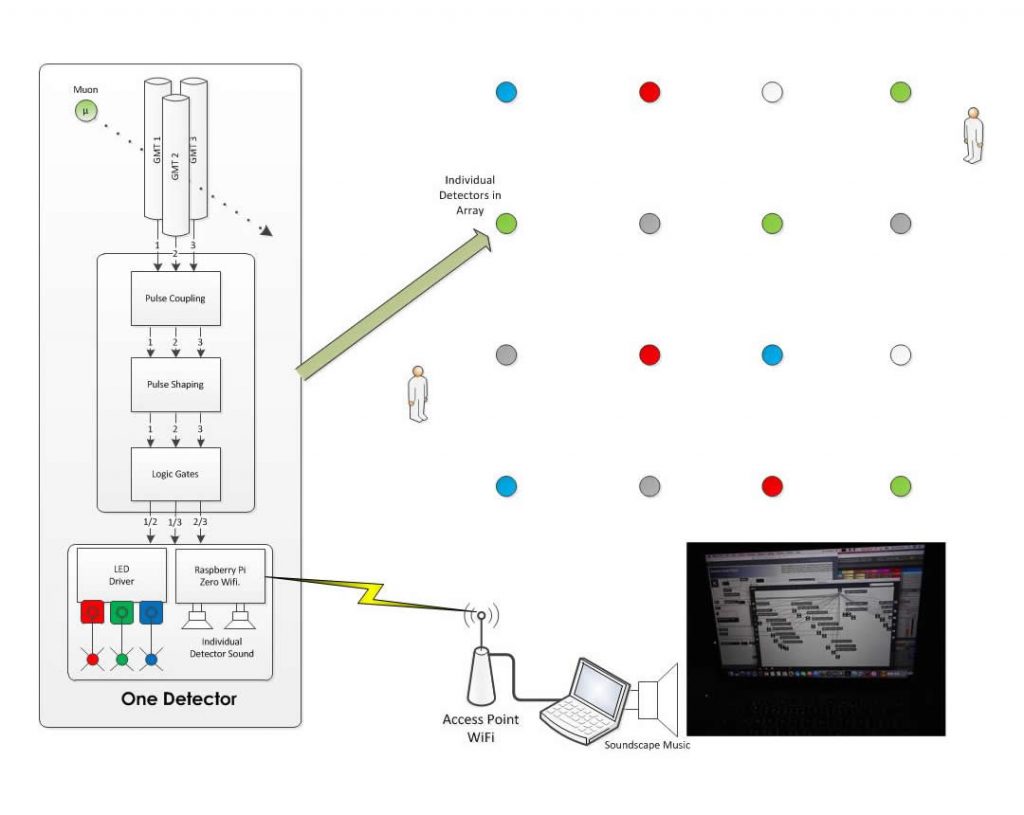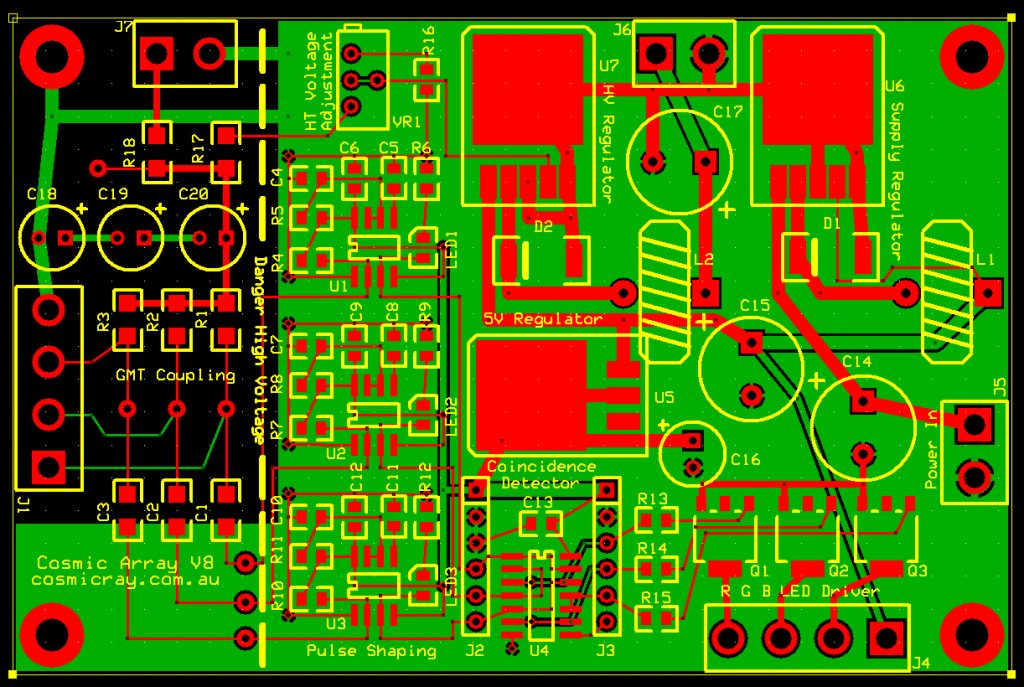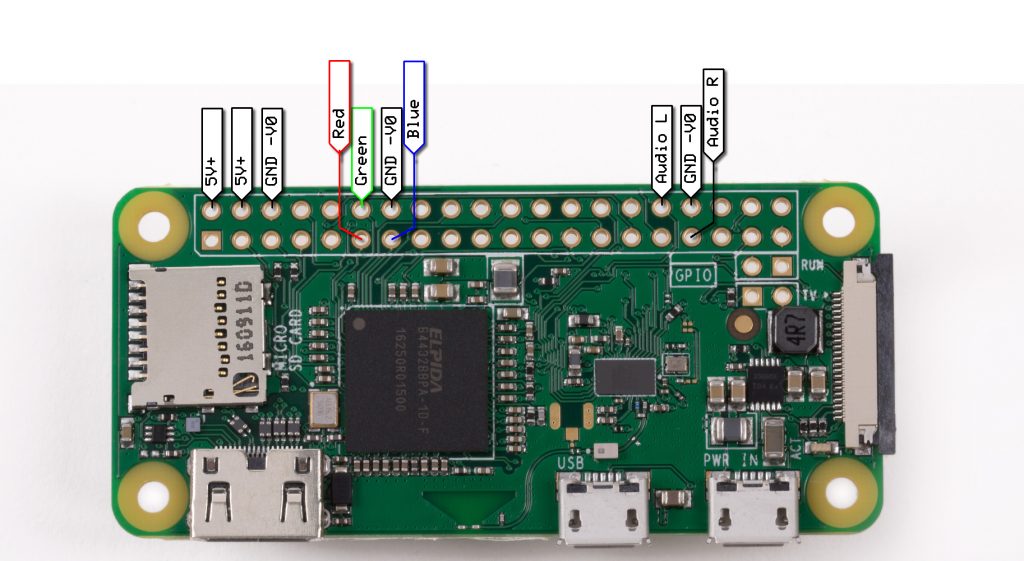This project deployed 16 individual cosmic ray detectors on the banks of the Elder Park foreshore in Adelaide. Supported by Splash Adelaide 2017 and is built in collaboration with Darren Curtis an artist-musician from Sacred Resonance.
When the public came to visit this installation, they experience how cosmic rays are all around us and arrive in showers of particles. Each detector randomly twinkles with colours and sounds triggered by cosmic rays. The experience not unlike colourful wind chimes.
However, as cosmic rays arrive in showers of particles, some of these detectors will trigger in unison and others randomly. A similar experience to what can be witnessed in nature like the sounds of Cicadas or the flashing light of Fireflies, where both sound and light fade in and out from randomness to unison.
Cosmic Rays have been present throughout the entire evolutionary history of life on our planet and so this display reinforces our connection with the universe and the importance of science and understanding the natural world.
The project had no agenda other than the first of many thought-provoking art/science installations. Which will provide an interesting window into the universe and the natural world around us, leaving the observer to form their own connections and conclusions.
Technical
Each detector in the array will produce a bright flash of one of 4 colours (red, green, blue or white). In the same manner, one of 3 musical notes ( e.g. C, F, G or other notes) or all 3 notes together depending on the direction and angle of an ionising particle called a muon passes through two or more Geiger–Müller tubes simultaneously. A combination of radiation copper shielding and coincidence detection methods were used to filter local background radiation.
The system used for playing sounds and other IoT functions utilises the latest Raspberry Pi Zero W and the code was developed by Paul Schulz. The IoT setup was very successful with this arrangement and were able to stream live data to another computer where it was mapped into music using MAX/MSP software.
Overview block diagram of operation includes
Circuit diagram of the central detector
PCB Layout of the central detector 96.5mm X 63.5mm
Raspberry Pi Zero W pinout
A note about Geiger–Müller Tubes
I’ve had comments regarding the validity of using Geiger–Müller Tubes for a cosmic ray (muon) detector. Pointing out that Photomultipliers and scintillation panels are best, and yes the are far more effective. However, they are also expensive, whereas Geiger–Müller tubes are relatively cheap and easily available to purchase.
Although I’m currently working on a solid-state detector there are a few issues yet to overcome, so this is still a few months away.
History is full of examples of physicists using Geiger–Müller tubes for cosmic ray observations up to the 80s. Geiger Tube Telescopes (GTT) were used by NASA including many Pioneer spacecraft missions and others. One most notable user was Bruno Benedetto Rossi a famous Italian experimental physicist who made major contributions to particle physics and the study of cosmic rays. At the age of 24, he fabricated his own Cosmic Ray detector using Geiger–Müller tubes and then went on to invent the first practical electronic coincident circuit.
This a part of a larger project I am developing and this proof of concept instaltion was a finalist in the 2017 Hackaday Prize competition.
https://hackaday.io/prize
https://hackaday.io/project/16568-cosmic-array
Winner of 2 semifinalist prizes
- https://hackaday.io/list/21839-thp-2017-semifinalists-design-your-concept
- https://hackaday.io/list/25542-thp-2017-semifinalists-internet-of-useful-things
News Stories:
http://www.glamadelaide.com.au/main/the-invisible-becomes-visible-at-the-torrens-this-september/
http://hackaday.com/2017/06/09/hackaday-prize-entry-cosmic-particle-detector-is-citizen-science-disguised-as-art/
https://blog.adafruit.com/2017/06/20/when-you-want-an-amazing-display-of-muons-citizenscience/



